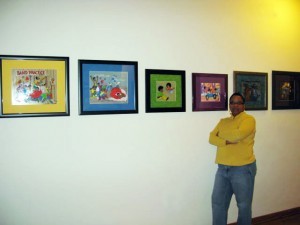The Museum Of UnCut Funk recently sat down with Felicia Lee from the New York Times for an interview about all things funky!
We met Felicia at the Schomburg Center and spent some time talking to her about why we do what we do and showing her some of our favorite funky things. An excerpt from her article is below. You can read the entire article at the New York Times website.
Did I mention that we made the front page of the Arts Section…of The New York Times!!!
Hey, Hey, Hey! Animated Touchstones
‘Funky Turns 40’ Recalls a Seminal Moment for Black Characters
By FELICIA R. LEE
MARCH 19, 2014
Growing up in the 1970s at opposite ends of New York State, two girls were immersed in all things cool, black and funky.
Saturday morning cartoons won their hearts. Loreen Williamson, in Rochester, and Pamela Thomas, in the Bronx, would park themselves in front of the “The Jackson 5ive,” featuring a tiny Michael sporting a big Afro, and “Josie and the Pussycats,” with the black tambourine-playing Valerie Brown performing in a hip girl band.
Eventually, the two met and bonded over their mutual interests. Not content to leave the funk (or their pasts) behind, Ms. Williamson, now 49, and Ms. Thomas, 51, have amassed more than 300 pieces of black animation art from the 1960s and ’70s, a collection that they believe is one of the world’s most extensive in that field. In 2007, they created the Museum of UnCut Funk, an online showcase for original animation cels, posters, storyboards and other objects celebrating black culture of the 1970s and its standard-bearers. Now, the two collectors have hit the road with a traveling museum exhibition, “Funky Turns 40: Black Character Revolution,” which represents 24 animated productions, including Saturday morning and after-school cartoons and animated feature films.
The revolution that it documents is from stereotype to superhero: “Funky,” which is currently at the Schomburg Center for Research in Black Culture in Harlem and will travel to museums in Chicago, Seattle and West Reading, Pa. honors the cartoons’ image-affirming black characters, including those of “The Harlem Globetrotters,” “Kid Power,” “Schoolhouse Rock” and “Fat Albert and the Cosby Kids.”
The programs are more than entertaining nostalgia, the two curators and some cultural historians say. They represent the fruits of a struggle for a say in the representation of blacks in television images, among other rights, and the newfound ability of popular black entertainers to get such programming on the air, based on their own appeal to a wide audience.
The shows offered a striking counterpoint to the previous stereotypical portrayals of blacks as buffoons in mainstream films, books, theater, advertising and cartoons. “It shows a time in American history when art and diversity and civil rights aspirations all came together,” said Christopher P. Lehman, a professor of ethnic studies at St. Cloud State University in Minnesota and the author of “The Colored Cartoon: Black Representation in American Animated Short Films, 1907-1954” (University of Massachusetts Press). “Before 1970, African-Americans were not much on television at all, except as the domestic servants of Jack Benny and Danny Thomas or as guests on variety series.”
It was no accident that “Hey, Hey, Hey, It’s Fat Albert,” described by curators as the first “positive” black-cast cartoon on TV (and the basis of the later series), was an NBC prime-time special in 1969, or, in the same vein, “The Jackson 5ive,” the first Saturday morning cartoon series featuring black musicians, made its debut in 1971. Both were created by two entertainment powerhouses, Bill Cosby (Fat Albert and the gang were part of his stand-up comedy routine) and Berry Gordy Jr., the founder of Motown Records, who marketed the family music act to appeal to the broadest possible audience.
Recalling her generation’s response, Ms. Williamson, who works as an independent consultant for marketing and business, said, “We got to see Martin Luther King’s dream, at least in cartoon form.”
To read the rest of the article please visit the New York Times website.




0 Comments